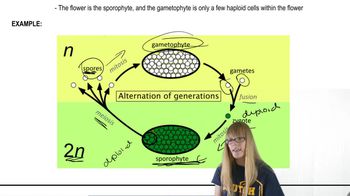Contrast spermatogenesis and oogenesis. What is the significance of the formation of polar bodies?
Table of contents
- 1. Introduction to Genetics51m
- 2. Mendel's Laws of Inheritance3h 37m
- 3. Extensions to Mendelian Inheritance2h 41m
- 4. Genetic Mapping and Linkage2h 28m
- 5. Genetics of Bacteria and Viruses1h 21m
- 6. Chromosomal Variation1h 48m
- 7. DNA and Chromosome Structure56m
- 8. DNA Replication1h 10m
- 9. Mitosis and Meiosis1h 34m
- 10. Transcription1h 0m
- 11. Translation58m
- 12. Gene Regulation in Prokaryotes1h 19m
- 13. Gene Regulation in Eukaryotes44m
- 14. Genetic Control of Development44m
- 15. Genomes and Genomics1h 50m
- 16. Transposable Elements47m
- 17. Mutation, Repair, and Recombination1h 6m
- 18. Molecular Genetic Tools19m
- 19. Cancer Genetics29m
- 20. Quantitative Genetics1h 26m
- 21. Population Genetics50m
- 22. Evolutionary Genetics29m
9. Mitosis and Meiosis
Development of Animal Gametes
Problem 24
Textbook Question
If one follows 50 primary oocytes in an animal through their various stages of oogenesis, how many secondary oocytes would be formed? How many first polar bodies would be formed? How many ootids would be formed? If one follows 50 primary spermatocytes in an animal through their various stages of spermatogenesis, how many secondary spermatocytes would be formed? How many spermatids would be formed?
 Verified step by step guidance
Verified step by step guidance1
Understand the process of oogenesis: Each primary oocyte undergoes meiosis I to produce one secondary oocyte and one first polar body. Therefore, from 50 primary oocytes, the number of secondary oocytes and first polar bodies formed will be equal to the number of primary oocytes.
Calculate the number of secondary oocytes and first polar bodies: Since each primary oocyte produces 1 secondary oocyte and 1 first polar body, the total secondary oocytes = 50 and total first polar bodies = 50.
Next, consider the formation of ootids: Each secondary oocyte undergoes meiosis II to produce one ootid (which will mature into an ovum) and a second polar body. Since the problem only asks for ootids, the number of ootids formed equals the number of secondary oocytes.
Understand the process of spermatogenesis: Each primary spermatocyte undergoes meiosis I to produce two secondary spermatocytes. Therefore, from 50 primary spermatocytes, the number of secondary spermatocytes formed is twice the number of primary spermatocytes.
Calculate the number of spermatids: Each secondary spermatocyte undergoes meiosis II to produce two spermatids. Thus, the total number of spermatids formed is four times the number of primary spermatocytes.
 Verified video answer for a similar problem:
Verified video answer for a similar problem:This video solution was recommended by our tutors as helpful for the problem above
Video duration:
1mPlay a video:
Was this helpful?
Key Concepts
Here are the essential concepts you must grasp in order to answer the question correctly.
Oogenesis Process and Outcomes
Oogenesis is the formation of female gametes where one primary oocyte undergoes meiosis to produce one secondary oocyte and one first polar body. The secondary oocyte then divides to form one ootid and a second polar body, but typically only one viable ovum results from each primary oocyte.
Recommended video:
Guided course

mRNA Processing
Polar Bodies Formation
Polar bodies are small cells produced during oogenesis that contain discarded genetic material. The first polar body forms after the first meiotic division, and the second polar body forms after the second division. They usually do not develop into ova and serve to reduce chromosome number while conserving cytoplasm in the oocyte.
Recommended video:
Guided course

Formation of Plant Gametes
Spermatogenesis Process and Outcomes
Spermatogenesis is the formation of male gametes where each primary spermatocyte undergoes meiosis I to form two secondary spermatocytes, which then divide in meiosis II to produce four spermatids. These spermatids mature into spermatozoa, resulting in four viable sperm from each primary spermatocyte.
Recommended video:
Guided course

mRNA Processing
Related Videos
Related Practice
Textbook Question
592
views


